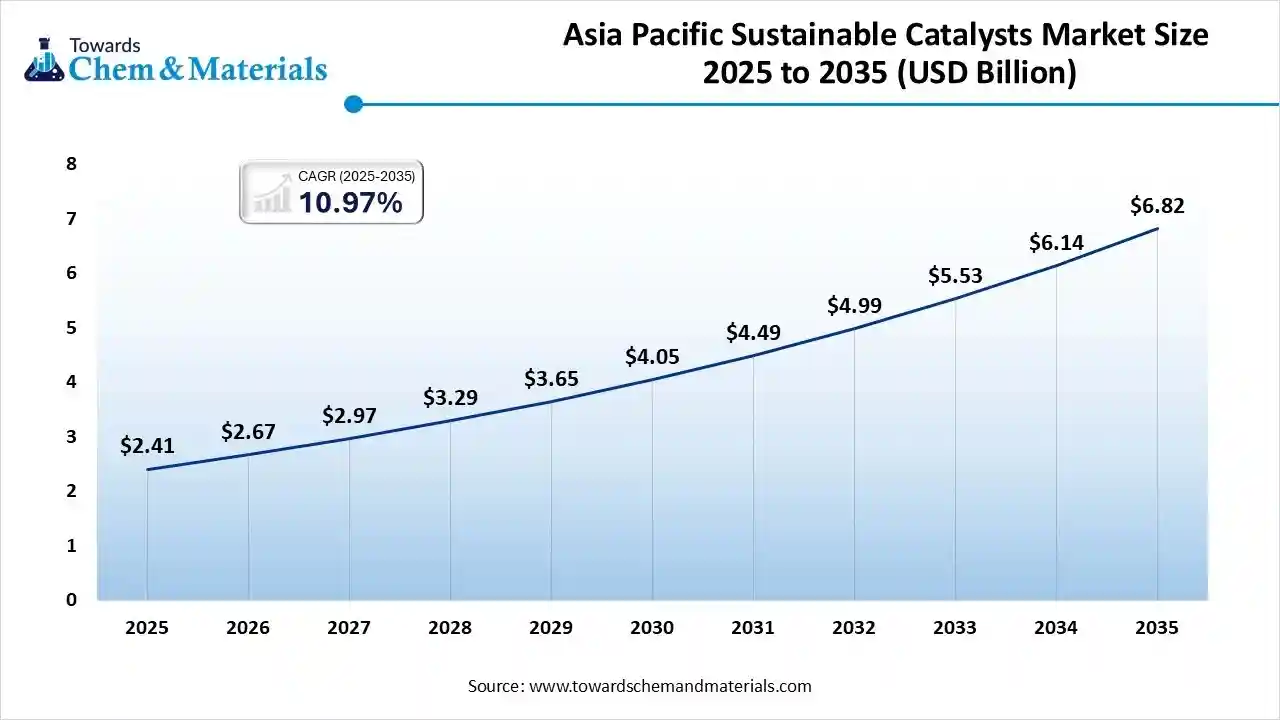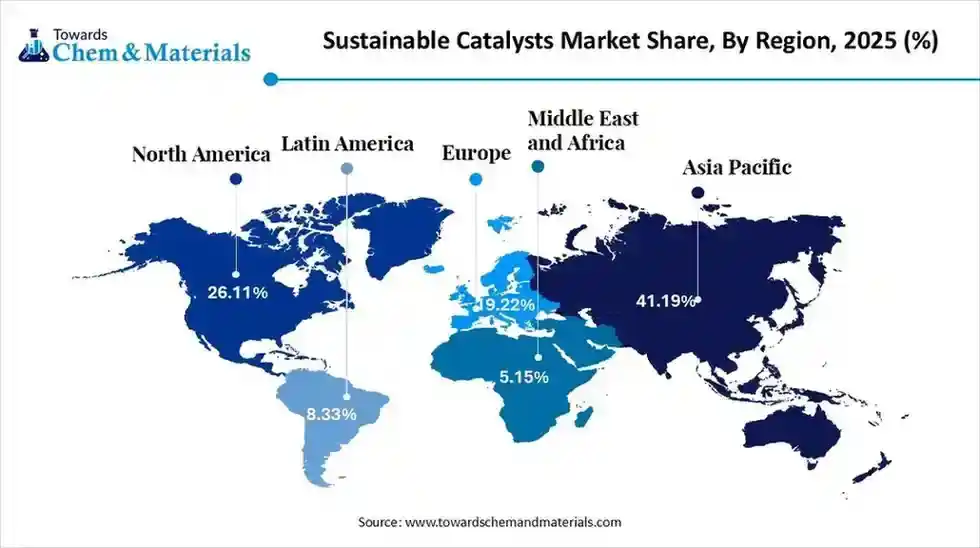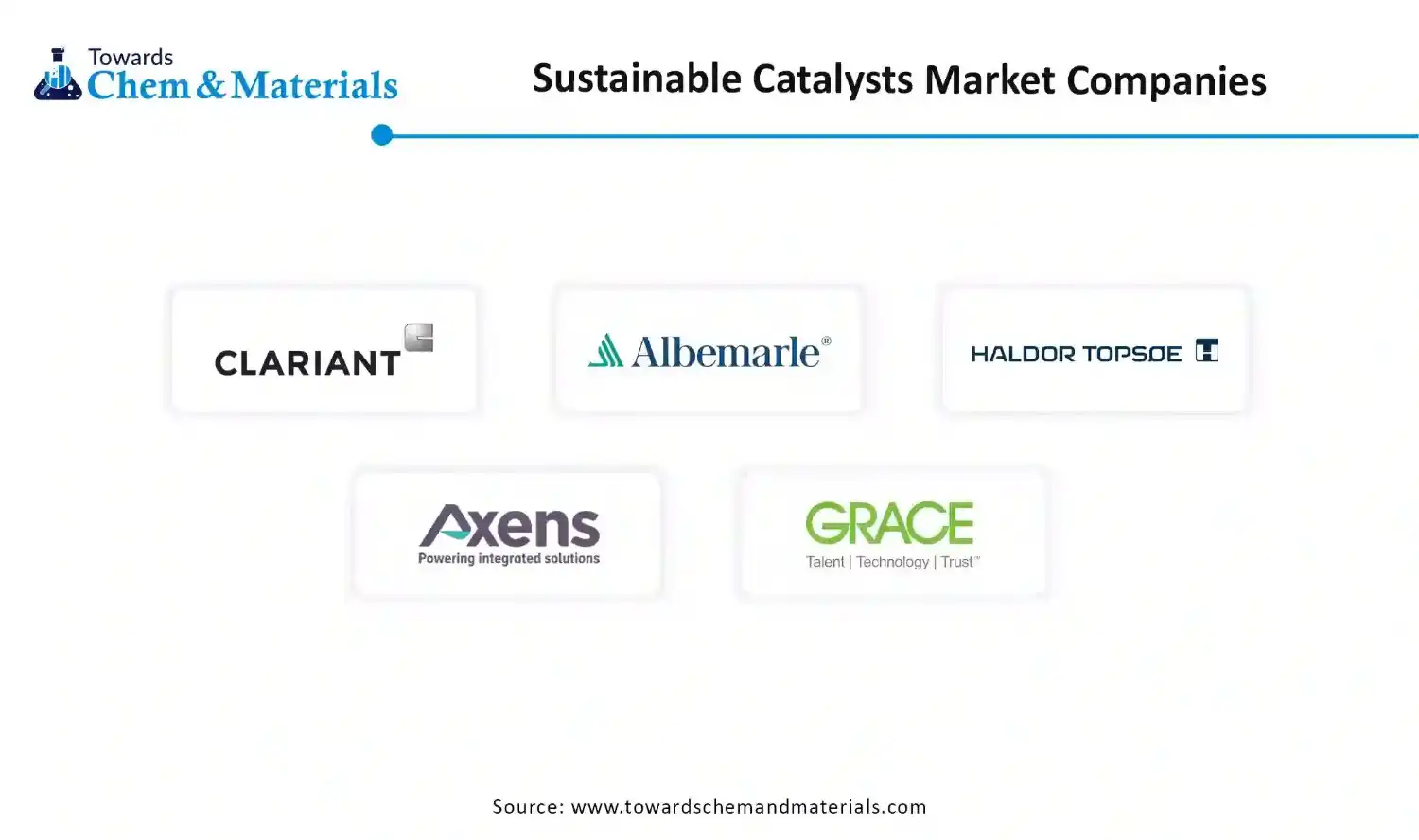November 2025
The global sustainable catalysts market size is calculated at USD 5.85 billion in 2025 and is predicted to increase from USD 6.49 billion in 2026 and is projected to reach around USD 16.54 billion by 2035, The market is expanding at a CAGR of 10.95% between 2026 and 2035. Asia Pacific dominated the sustainable catalysts market with a market share of 41.19% the global market in 2025.The global shift towards clean energy has accelerated market potential in recent years.

The sustainable catalyst refers to the specific material that allows chemical reactions to speed up while creating less waste with less energy. Moreover, several major brands are seen under the heavy demand for sustainable catalysts while replacing traditional catalysts, which are made from rare and toxic metals. Also, the global governmental push towards eco-friendly manufacturing is contributing to the industry's growth in recent years.
The AI-designed catalysts and real-time optimization are emerging as the major technology shift of the sustainable catalyst market in the current period. Moreover, the Artificial Intelligence models that have data of various material combinations, which is creating an easy way for manufacturers to develop more environmentally friendly and new catalysts in recent years, as per the latest survey.
| Report Attribute | Details |
| Market Size Value in 2026 | USD 6.49 Billion |
| Revenue Forecast in 2035 | USD 16.54 Billion |
| Growth Rate | CAGR 10.95% |
| Forecast Period | 2026 - 2035 |
| Base Year | 2025 |
| Dominant Region | Asia Pacific |
| Fastest Growing Region | Europe |
| Segments covered | By Catalyst Type, By Material Composition, By End-User Industry, By Processing Technology, By Region |
| Key companies profiled | BASF SE, Johnson Matthey, Evonik Industries AG, Clariant AG, Albemarle Corporation, Haldor Topsoe A/S, Axens, W.R. Grace & Co. |
| Country / Region | Regulatory Body | Key Regulations | Focus Areas |
| United States | Environmental Protection Agency (EPA) | Toxic Substances Control Act (TSCA) | Promoting "green chemistry" to eliminate hazards at the design stage. |
| European Union | European Chemicals Agency (ECHA) | REACH Regulation (EC) 1907/2006 | Incentivizing the design of inherently safe chemicals and processes ("Safe and Sustainable by Design" framework) |
| China | Ministry of Ecology and Environment (MEE) | Environmental Protection Law | Driving demand for advanced catalytic processes to meet stringent environmental regulations and national carbon reduction goals |
How did the Zeolite-Based Green Catalysts Segment Dominate the Sustainable Catalysts Market in 2025?
The zeolite-based green catalysts segment dominated the market with approximately 31.86% industry share in 2025 due to factors like stability, durability, and easy reusability. Moreover, by trapping harmful molecules while speeding up reaction efficiency, zeolite-based green catalysts have gained a heavy consumer base in the current period.
On the other hand, the electrocatalyst segment is expected to grow at a significant rate with approximately 20% CAGR owing to the global shift towards the electrified and renewable chemical production in recent years. Also, by minimizing the cost of production due to avoiding fossil fuel and high heat usage, the electrocatalyst is likely to emerge as an ideal option during the forecast period.
The bio-based catalyst segment is also notably growing, owing to its direct sourcing from natural sources algae, plants, and agriculture, while maintaining sustainability. Moreover, by reducing the dependence on mined metals and cutting down the environmental toxicity, the bios-based catalyst has changed the catalyst industry pattern in recent times.
Why does the Metal-Based Catalysts Segment Dominate the Sustainable Catalysts Market by Material Composition?
The metal-based catalyst segment dominated the market with approximately 46.77% industry share in 2025, because they are well-studied, easy to control, and already widely used in major industries. Metals like nickel, copper, iron, platinum, and palladium offer strong and predictable performance. Factories rely on them for refining fuels, producing polymers, and making chemical intermediates.
The organic catalysts segment is expected to grow at a 19% CAGR because industries want safer, lighter, and more recyclable chemicals. Organic catalysts are made from carbon-based molecules instead of heavy metals, so they avoid toxic residues. They are also easier to tune, small adjustments in structure change their behavior, allowing more precise reactions.
The hybrid catalyst segment is also notably growing because it combines the best features of metal, organic, and bio-based components. This gives them unique advantages- high strength, stability, selectivity, and lower environmental impact. Many factories want catalysts that can survive tough conditions but still meet green rules.
Why does the Chemicals and Petrochemicals Segment Dominate the Sustainable Catalysts Market by End User?
The chemicals and petrochemicals segment dominated the market with approximately 41.74% of industry share in 2025 because it uses huge amounts of catalysts every day. These factories need catalysts for cracking, hydro-treating, polymer production, and gas purification. Since they generate large emissions, switching to sustainable catalysts helps them meet new environmental rules quickly.
The energy and power segment is expected to grow at a rapid rate with a 19% CAGR because it is shifting toward renewable fuels, green hydrogen, and carbon-neutral systems and all of which depend heavily on sustainable catalysts. Electrocatalysts for water splitting, catalysts for CO conversion, and solid-oxide catalyst materials are becoming essential.
The pharmaceuticals segment is also notably growing because drug companies need cleaner and more precise chemical reactions. Sustainable catalysts help reduce impurities and create fewer byproducts, which improves medicine quality. New organic and enzyme-based catalysts allow drug production at lower temperatures, cutting energy costs and helping companies meet environmental goals.
Why does the Heterogeneous Catalyst Segment Dominate the Sustainable Catalysts Market by Processing Technology?
The heterogeneous catalyst segment dominated the market with approximately 56.34% industry share in 2025, because they are solids that remain separate from the reaction mixture, making them easy to remove and reuse. Factories prefer them because they are clean, safe, and ideal for continuous processing.
The electrocatalyst segment is expected to grow at a 19 to 20% CAGR owing to industries switching to electricity-driven chemical production to reduce emissions. Electro-catalysts use renewable electricity to run reactions, making processes efficient and low-carbon.
The enzyme-based biocatalyst segment is also notably growing because it comes from nature and works under mild, energy-saving conditions. They help create cleaner products with fewer impurities, which is important for the food, pharma, and cosmetics industries.
The Asia Pacific sustainable catalysts market size was valued at USD 2.41 billion in 2025 and is expected to reach USD 6.82 billion by 2035, growing at a CAGR of 10.97% from 2026 to 2035. Asia Pacific dominated the sustainable catalysts market with approximately 41.19% industry share, owing to the presence of one of the leading and biggest chemical, materials, and petrochemical manufacturing bases.

Furthermore, the regional countries such as India, China, and Japan have seen in the production of higher volumes of chemicals which leading to the demand for efficient and affordable catalysts in the current period. Also, the heavy investment toward clean energy has contributed to a major share in the sustainable catalyst market growth in the past few years.
China Strengthens Its Lead in The Global Sustainable Catalysts Market
China maintained its dominance in the sustainable catalysts market due to the heavy expansion of yeh green manufacturing in the country. Moreover, the greater government push towards sustainable manufacturers has played a major role in the adoption of the sustainable catalyst in the manufacturing sector in China nowadays.
Europe Sustainable Catalysts Market Examination
Europe is expected to capture a major share of the sustainable catalysts market, owing to the stricter environmental rules than other regions. Moreover, the region has seen under significant investment in green hydrogen and carbon-neutral factories, which is likely to create lucrative opportunities for sustainable catalyst manufacturers in the coming years.
Green Fuels and Hydrogen Push Propel Germany’s Catalyst Market Growth
Germany is expected to emerge as a prominent country for the sustainable catalysts market in the coming years, owing to the stronger automotive and engineering industries, where the high-performance catalyst has seen under heavy demand. Moreover, the major manufacturers in Germany have heavily invested in electrocatalysts for ammonia, hydrogen, and green fuels in recent years.

North America Sustainable Catalysts Sector Evaluation
North America is a notably growing region due to the ongoing shift towards electrified chemical production and early access to advanced technology. Furthermore, the regional countries like Canada and the United States have observed under a heavy investment in the development of the biased catalyst in the current period.
AI-Driven Catalyst Breakthroughs Position the United States at the Forefront of Clean Tech
The United States is expected to gain a major industry share because it invests in green hydrogen, clean fuels, and carbon-reduction technologies. American companies develop electro-catalysts for water splitting, metal-free catalysts, and enzyme-engineered bio-catalysts. Many startups use AI to design novel catalyst structures.
Sustainable Catalysts Market Study in the Middle East and Africa
The Middle East and Africa are expected to capture a notable share of the sustainable catalysts market because the region wants to shift from oil dependence to clean and value-added industries. Many countries are investing in green hydrogen, ammonia, and carbon utilization projects, all requiring advanced electro-catalysts and hybrid catalysts. Extreme climates also push industries to adopt efficient catalysts that reduce energy use.
Saudi Arabia Accelerates Sustainable Catalysts Innovation Under Vision 2030
Saudi Arabia is expected to emerge as a prominent country for the sustainable catalysts market in the coming years because the country has seen in investing heavily in green hydrogen, circular chemicals, and clean manufacturing as part of Vision 2030. New mega-projects require efficient electro-catalysts and hybrid catalysts to produce hydrogen, ammonia, and synthetic fuels.

By Catalyst Type
Bio-Based Catalysts
By Material Composition
By End-User Industry
By Processing Technology
By Region
November 2025
November 2025
November 2025
November 2025